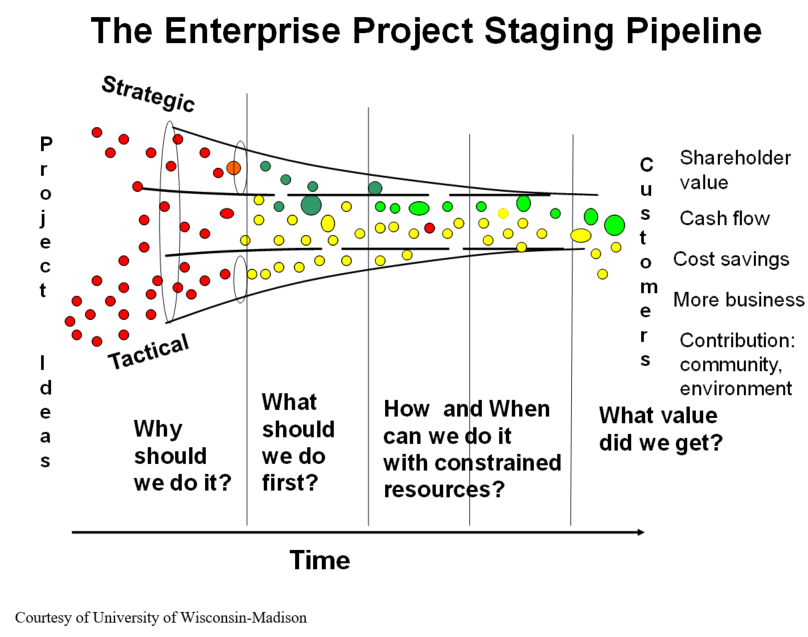
Part 2: The Enterprise Staging Project Pipeline
Read Part 1: The Problematic Project Pipeline
By: Barb Schrage
The goal of project portfolio management is to work on the right projects at the right time for the right costs balanced to resource capacity to achieve the strategic and business objectives of the organization. Project Portfolio Management consists of three overall processes: Define the project portfolio (prioritization), manage the project portfolio (re-balance) and measure the project portfolio.
The following steps are discussed in greater detail with experienced project managers and project management office directors in my course, Project Portfolio Management.

7 Steps to define the project portfolio
1. Create a solid business case for each proposed project that describes and justifies the need for the project. Questions to answer within the business case include:
- Why should we do the project at this time?
- What is the problem to be solved or the business opportunity to be achieved and what is the proposed solution? Include cost estimates, resources, and time.
- What is driving the timing of the project?
- How does this project support the achievement of business strategies and objectives?
- What are the business outcomes and value to the organization?
2. Prioritize the proposed projects to create an initial ranked list
- Create ranking criteria based on business value, which include the tangible and intangible benefits that are critical to the organization. If there are too many ranking criteria, prioritization will become unwieldly and result in very few data spreads in the scoring. Ideally, the number of ranking criteria should be between four and seven. Optional: provide weights for each of the ranking criteria.
- Score each of the proposed projects against the ranking criteria. The ranking criteria data should be included in each of the business cases for the proposed projects. Sort by the total scores to create the initial ranked list of proposed projects.
- Analyze the results of the initial ranked list of proposed projects to confirm the highest priority projects provide the greatest business value to the organization, based on the current strategic and business objectives. Also, consider calendar timing and dependencies with other projects within the portfolio.
3. Compare against the organization’s constrained resources (budgetary or resource capacity). Total up the estimated costs and resources (hours or percentage of full-time equivalents) for the initial ranked list of proposed projects. This data should also be included in the proposed business cases. Compare the total estimated costs and resources from the initial ranked list of proposed projects to the resource capacity (cost and resources) and indicate where in the ranked list of projects the capacity is exceeded.
4. For the projects that fall above the capacity line, determine the correct timing and pacing of the projects and create a roadmap dashboard report. Within this report, each proposed project should show along a calendar timeline, the length of each project and within which month it should start. There may be a perceived pressure and sense of urgency to start all the projects at the same time, which will also clog the project pipeline.
5. Another option is to add graphics that represent what percentage of the proposed projects’ total cost or total resource hours fall into specified categories. There are many different types of these categories. One example of a specified category could be which corporate or business strategy does each project most align to and directly support. These types of graphics can answer the question: does the portfolio contain the right mix of projects?
6. Work with the project portfolio governance team to gain approval on the proposed project portfolio, which is the list of proposed projects that fall within the resource capacity. Strategic decisions are made at this point. Are these the right projects for the organization to commit resources to? Is it the right mix of projects? Do these projects represent our organization’s intent, direction, and priorities? Also, there may be questions and discussions by the governance team about how to increase resource capacity (money and/or people), or how to increase efficiency, or how to reduce the cost and/or resource estimates for each of the projects that either fall above or below the budget and/or resource capacity line so that more projects can get done.
7. Publish the approved project portfolio along with the project roadmap dashboard report that shows the pacing for each of the projects along a calendar timeline.
Barbara Schrage, PMP, MCPM, teaches Project Portfolio Management at the Wisconsin School of Business Center for Professional & Executive Development. To learn more about her upcoming courses, please contact [email protected] .
About the Instructor: Barb Schrage

Barbara owns a consulting business called Practical Project Management, LLC. She helps her clients mature their project management practices in various ways, such as implementing Project Management Offices, implementing Project Portfolio Management, and standardizing and improving their project management processes. Besides teaching classes within UW’s Masters Certificate of Project Management series of courses, she also teaches on-site Project Management courses within organizations. In addition, she coaches and mentors leaders of PMOs and Project, Program and Portfolio Managers. Besides her experience in the Financial Services industry, her clients have spanned various industries, such as health care, energy/utility, engineering, manufacturing, biotech research, government, retail, and market research.